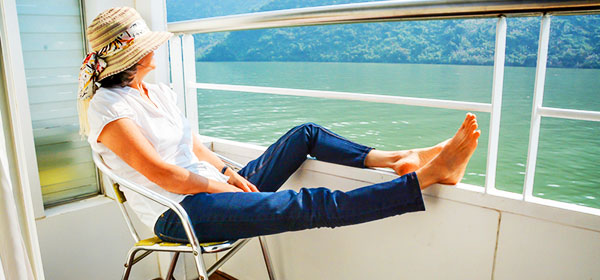Australians love cruising. In fact, it is one of the most popular forms of travel in the land (and not coincidentally, on the sea!). Per capita, Australia is the biggest cruising country in the world.
So, it’s unsurprising that, for many retirees, a cruise holiday sits atop the wishlist.
Whether you’re a first-time cruiser or just want to bone up on your boat know-how, these seven tips from seasoned sailors will ensure that you ‘own’ your next cruise experience.
1. Don’t pack the kitchen sink
You don’t need three pairs of dress pants and six shirts for a seven-day cruise. In fact, you can probably remove half of whatever you pack in your bag. Just take the necessities and be comfortable. Yes, you’ll need a nice shirt and pair of pants, maybe a dinner jacket, but the rest is cool casual. You’ll be sitting poolside half the time, so think shorts, bathers, singlets and T-shirts. And cruise ships are floating citadels, complete with shops and all manner of services, so whatever you miss when packing can essentially be purchased onboard.
SJ has written a comprehensive guide to cruise packing, so do yourself a favour and check it out!
2. Book your activities in advance
If you want a helicopter ride in Hawaii or to paraglide in Papua New Guinea, it pays to get in early and either book before you pull out of port or as soon as you board. The benefit of doing it before you board is not having to stand in long queues at the start of your journey. Departure day and the morning after are the two peak times for booking shore excursions, buying beverage packages and making appointments for other onboard services.
And while we’re discussing activities, if you do miss out on a theatre show or special onboard event, stick around after the doors open and you’ll be given a shot at free seats, as people often book them and don’t show up.
3. Cruise cash
Nowadays, most ships use a cruise card system where, once you board, you receive a swipe card that’s connected to your credit or debit card, or room number. All of your onboard purchases are made with this card (for better or for worse), so treat it just as you would a credit card.
However, once you step off the boat, you’re expected to use the currency of the country you’re in. So, to save yourself major exchange fees, it might be wise to know which currencies you’re most likely to need and purchase some beforehand. ATMs on board will charge something like US$6 per transaction – much cheaper to buy from a currency exchange bureau at your local shopping centre.
4. Know when big events are happening
Checking out when the big cabaret, comedy or ice shows are on will most likely coincide with when the pools, spas, gyms, casinos and other activities are quiet. So, if you don’t like the crowds, this is the best time to get in and have some fun.
Same goes for port calls: when half the ship is onshore, the other half get to enjoy the peace and quiet onboard.
5. All you can eat
Perhaps the best feature of cruising is how much is included in the fare. Pretty much all food, apart from some specialty restaurants, is included. And these restaurants are open all day (and sometimes, night). If you’re a stickler for a traditional breakfast, then book your spot in the dining room ahead of time. Or you can just show up, but expect a bit of a wait.
Just know that most ships have incredible buffets that offer all types of food at all hours, so you’re not beholden to a specified dining time. Eat all you want whenever you want. That’s the beauty of cruise ship dining.
Oh, and if you take our advice and book a cabin balcony, you can order room service and eat al fresco overlooking cerulean blue seas each day. Nice!
6. Sit at a communal table
When booking a dining time, you may be given the choice of a table for two (or one) or sitting at a communal table. Do yourself a favour and take the more sociable option a few times during your cruise. You’ll learn invaluable tips from other cruisers and also be able to ask which shows or activities are worth the bother. And you might make some new friends in the process!
7. Take advantage of free lessons
Some ships will have a set activity agenda sent through with your ticket or handed to you when you board. Check out all the free activities and lessons and do as much as you can. You’ll not often be able to learn salsa dancing sans lesson fees, or how to paint watercolour landscapes or even partake of free yoga and meditation. Take the opportunity to learn while you’re onboard and you’ll gain much more from your holiday than just rest, relaxation and a tan.
Do you have any tips for new cruisers? Why not share them with our members?
Related articles:
Cruises: can I try before I buy?
Top tips for cruise ships
Cruise fares explained

